| |
 CLICK ON IMAGES FOR ADDITIONAL DETAILS
CLICK ON IMAGES FOR ADDITIONAL DETAILS
unless accompanied by "not linked" icon.
|
| HEXANCHIFORMES |
|
|
|
|
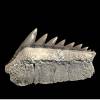 |
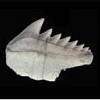 |
Hexanchus griseus (BONNATERRE, 1788)
aka H. gigas (SISMONDA, 1857) — Sixgilled shark
Hex teeth are hard to come by and very desirable (Notorynchus teeth seem to outnumber them by 20 to 1. | |
|
Purdy, et al (2001) were reluctant to validate H. gigas noting the similarities with the extant species H. griseus and listed these teeth as Hexanchus sp. |
|
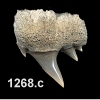 |
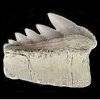 |
Notorynchus cepedianus (PERON, 1807) aka
N. primigenius (AGASSIZ, 1843) — Sevengill shark.
This species' lowers are always a pleasure to find and their symphyseals are amongst the most desired at Lee Creek. | |
| Traditionally ascribed to primigenius;Purdy, et al (2001) note, these teeth are indistinguishable from the extant species. They attribute them to Pungo units 1-5 and Yorktown 1-2. |
|
| SQUALIFORMES |
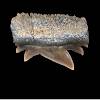 |
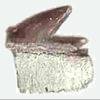 |
Echinorhinus blakei AGASSIZ, 1856
Bramble shark
Teeth are uncommon, dermal denticles can be found by screening. Purdy, et al (2001) note that these teeth are found in Pungo River units 4 & 5. |
|
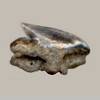 |
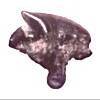 |
Squalus cf acanthias LINNAEUS, 1758 — Spiny Dogshark.
Teeth found
in lower Yorktown; Purdy, et al (2001) attribute to Yorktown units 1 & 2, but not to a particular species. They note its similarities with S. almeidae (more robust than S. acanthus). |
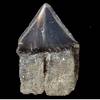 |
Isistius cf triangulus (PROBST, 1879) —
Cookiecutter Shark
A relatively uncommon tooth usually derived from lower Yorktown tailings. Purdy, et al (2001) merely refer to these teeth as Isistius sp and attribute them to Yorktown units 1-3. |
| . |
| PRISTIOPHORIFORMES |
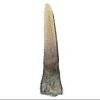 |
Pristiophorus sp - Sawshark
Sawsharks are a little-known species at Lee Creek. The rostral teeth are very uncommon and can be found by fine screening mine waste of the Pungo River formation. The accompanying specimen is 7mm high. Purdy, et al (2001) also stick with the genus only and attribute them to Pungo River units 1-3. |
| . |
| SQUATINFORMES |
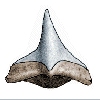 |
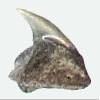 |
Squatina sp — Angel shark
A somewhat common species particularly of the lower Yorktown. The illustrated tooth is 5.0 mm in height. Purdy, et al (2001) make no attempt to assign these to a particular species but indicate they are found in Pungo River (units 4 & 5) and Yorktown (1 & 2) sediments.
|
| . |
| ORECTOLOBIFORMES |
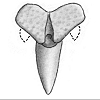 |
 ?Parascyllium sp — Collared carpet shark
?Parascyllium sp — Collared carpet shark
Only two examples of this tooth-design known (from Pungo River tailings).
Roots characterized by the incomplete nutrient groove. This genus is currently known from the western Pacific (off Australia). The illustrated example is 3.2 mm in height.
Not included in Purdy, et al (2001). |
| |
Megascyliorhinus miocaenicus ANTUNNES & JONET, 1969-70
Extinct parascyllid
Purdy, et al (2001) report of a single specimen from the basal Pungo River (unit 1). |
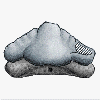 |
Ginglymostoma cf cirratum (BONNATERRE, 1788)
Nurse shark.
The illustrated tooth measures 3.0 x 5.0 mm and is from Pungo River tailings. Purdy, et al (2001) include from this genus a single Pungo River (unit 3) tooth and ascribe it to Ginglymostoma sp. |
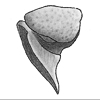 |
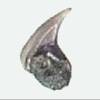 |
Rhincodon cf typus SMITH, 1829
Whale shark
Regularly found in Pungo River reject tailings, these teeth are laterally compressed. The illustrated tooth measures 5.4 mm in height. |
| |
Purdy, et al (2001) elected to not assign these teeth to a particular species and report them from Pungo River units 1-3. |
| . |
| LAMNIFORMES |
The Sand Tigers
I've never found myself particularly adept at distinguishing sand tigers and have tended to rely on others ((i.e., Cunningham, Heim, Purdy and Ward). The publication of Purdy et al (2001) further confused things in my mind. They include Carcharias taurus, C. cuspidata, an unidentified (C. contortidens-like) species, Odontaspis ferox and O. cf acutissima. ELASMO.COM's listing had previously included C. taurus (aka C. acutissima), C. cuspidata, C. reticulata and O. ferox. The net result, was that teeth previously ascribed to C. reticulata were being listed as O. cf acutissima.
At first, their (Purdy et. al) arguments sounded pretty good, and the reassignments were included on this page. However, these conclusions were not broadly embraced (ignored or rejected by European paleontologists). Attempting to usurp acutissima for the small odontaspid teeth leaves those identified elsewhere as C. acutissima, nameless.
To maintain a continuity with commonly accepted identifications, acutissima (probably not in the Mio-Pliocene fauna of Lee Creek), cuspidata and taurus will be deemed (for now) all to be valid Carcharias species and both reticulata and ferox, Odontaspis species.
With that said, it is the ELASMO.COM opinion that two sand tiger genera are present — Carcharias and Odontaspis. The former is represented by two Lee Creek species (cuspidata and taurus) and the later by reticulata and ferox.
|
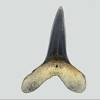 |
Anomotodon craevenensis CASE 1980 - Extinct Goblin shark
Recovered from upper Pungo River sediments, this single specimen is likely re-worked from underlying Oligocene sediments. Not reported by Purdy et al (2001). |
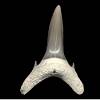 |
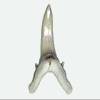 |
Carcharias taurus RAFINESQUE, 1810
aka C. acutissima (AGASSIZ, 1844) - (extinct) Sand tiger
Common in the mine, Purdy et al (2001) ascribes these teeth to C. taurus and note their presence in the Yorktown (units 1 & 2) and James City Formations. Others prefer the usage of C. acutissima for these teeth, possibly incorrectly. |
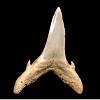 |
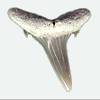 |
Carcharias cuspidata (AGASSIZ, 1843)
Extinct Sand Tiger shark
The abundant sand tiger of the Pungo River, Purdy et al (2001) note this species as present in Pungo River (units 1-3) and Yorktown (units 1 & 2) sediments. |
| |
Carcharias sp — Extinct Sand Tiger shark
Purdy et al (2001) include these Pungo River (unit 1-5) teeth which they note as being very similar to C. contortidens (AGASSIZ, 1843) and reject Leriche's 1910 synonymization of these teeth with O. acutissima. Their illustration shows C. cuspidata-like teeth with mesio-distally compressed roots. |
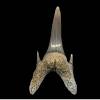 |
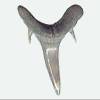 |
Odontaspis reticulata (PROBST, 1879)
aka Carcharias reticulata
aka O. cf O. acutissima (AGASSIZ, 1844)
Extinct smalltooth sand tiger shark
These small, slender teeth are found in Pungo River tailings. Purdy et al (2001) include these common Pungo River (unit 1-5,?6) teeth as O. acutissima.
|
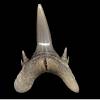 |
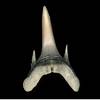 |
Odontaspis ferox (RISSO, 1810)
Smalltooth sand tiger shark.
A scarce slender-toothed species, Purdy et al (2001) found these teeth to be somewhat common (35 specimens) in the Pungo River (units 1-5). |
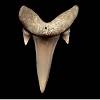 |
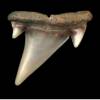 |
Carcharoides catticus PHILIPPI, 1846
Exinct genus
A scarce Pungo tooth. Purdy et al (2001) included these in the Pungo River's units 1-3 as Triaenodon. |
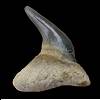 |
Megachasma sp - Megamouth shark
These teeth are very scarce and known from Yorktown sediments; the erect cusps are unlike those of the extant species. Purdy et al (2001) also included smaller Pungo Unit 1-3 specimens, but in this author's opinion, the identification of these Pungo River teeth is questionable.
|
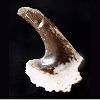 |
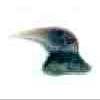 |
Cetorhinus sp — Basking shark
Teeth and gill-rakers of this species are reported from the mine. Purdy et al (2001) also reported a calcified clasper spine and did not assign their Pungo (unit 3) material to a particular species. |
| . |
| Carcharodon vs Carcharocles
The most famous sharks of Neogene seas remain in phylogenetic limbo as those
best able to evaluate the subject debate their heritage. In the early 90's, the genus Carcharocles came into vogue. If the extant Great White is viewed as a descendant of Cosmopolitodus, then Carcharocles would be the proper genus.
Purdy et al (2001) synonymize Palaeocarcharodon and Carcharocles with Carcharodon, and reject Otodus and Cosmopolitodus (Isurus) as part of the lineage. This website's considers Carcharocles the proper genus for this tooth-design. |
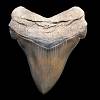 |
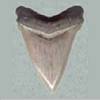 |
Carcharocles chubutensis (AMEGHINO, 1906)
aka subauriculatus (AGASSIZ, 1839)
extinct Megatoothed shark
Large teeth with lateral cusplets from Miocene tailings; Purdy et al (2001) refer to as Carcharodon subauriculatus; Pungo (units 1-5). |
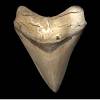 |
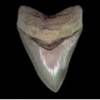 |
Carcharocles megalodon (AGASSIZ, 1837)
extinct Megatoothed shark.
The largest and best known shark tooth from a huge predator of Pliocene seas. The mine regularly produces near perfect specimens over five inches in height. |
| |
Purdy et al (2001) prefer the genus Carcharodon and include these teeth in Pungo (units 4-6) and Yorktown (unit 1) sediments. |
| . |
| Carcharodon vs Isurus
January '98. Now, if you ascribe to the notion that Carcharocles is the proper genus for the mega-toothed sharks, then where did Carcharodon carcharias come from? Well, the broad-toothed 'makos' would be the logical answer. That then beckons the the question -- should all the broad-toothed 'makos' be assigned to Carcharodon.See: Sacaco Great White Mako?
Carcharodon vs Cosmopolitodus
January '99. During a SHARK-L list server discussion, Mikael Siverson went public with research in progress by himself and David Ward. Their current thinking is that Glikman's genus, Cosmopolitodus, should be resurrected for the teeth currently referred to as the broad-toothed 'makos'. This genus would include the Eocene species praecursor and the Mio-Pliocene species hastalis, "xiphodon", planus and esheri.
Carcharodon vs Cosmopolitodus II
June 2001 saw the release of Lee Creek III. In this volume, the authors present their evidence that C. carcharias was not derived from hastalis/"xiphodon". They note their key arguments to be:
1) juvenile "xiphodon" lower A1s have root lobes of equal length which form an acute angle rather than an elongated mesial root lobe and obtuse angle as in juvenile C. carcharias'.
2) C. carcharias strong and "xiphodon" weak ontogenetic heterodonty.
3) Unlike C. carcharias, the lower A2 of "xiphodon" is the largest anterior tooth.
4) Mitochondrial DNA sequences estimate the origin of Carcharodon to be in the Palaeocene or Eocene.
|
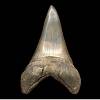 |
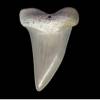 |
Cosmopolitodus (aka Isurus) hastalis
(AGASSIZ, 1843) extinct White shark
Teeth of this species are the most common "mako" tooth found at Aurora.
They are often characterized by the broad flat labial root face. |
| Purdy et al (2001) include these teeth as Isurus from the Pungo (units 1-5) and Yorktown (units 1-3).
Also see: Cosmopolitodus |
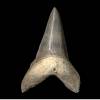 |
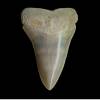 |
Cosmopolitodus (aka Isurus) "xiphodon"
(AGASSIZ, 1833-44)
extinct White shark
This species was resurrected by Purdy (1996), for teeth previously attributed to I. hastalis and/or I. retroflexus. |
| Purdy et al (2001) include broad versions of the hastalis-design in this species which they relegate to Yorktown units 1 & 2. Also see: Cosmopolitodus. This author currently considers these teeth to represent the broad-form of hastalis. |
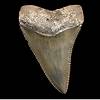 |
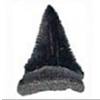 |
Carcharodon carcharias (LINNAEUS, 1758)
Great White shark.
Teeth found in James City, Chowan River, and less commonly, upper Yorktown. Purdy et al (2001) attribute these teeth to Yorktown ?unit 1 and the James City Fm. |
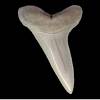 |
Isurus oxyrinchus RAFINESQUE, 1809 (extant)
aka I. desori (SISMONDA, 1849) (extinct)
Shortfin mako
Teeth are laterally compressed with crowns more robust than Cosmopolitodus hastalis. Purdy et al (2001) consider desori a junior synonym of oxyrinchus and note it from the Pungo River (units 1-5) and Yorktown (units 1 & 2) Formations. |
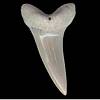 |
Isurus retroflexus (AGASSIZ, 1843) (extinct}
aka I. paucus GUITART MANDAY, 1966 (extant) Longfin mako
The second narrow-toothed species at Lee Creek is thought by some to be attributable to teeth from various positions belonging to other species. Purdy et al (2001) consider neither retroflexus nor paucus to be represented in the fauna. |
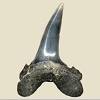 |
Lamna nasus (BONNATERRE, 1788) (extant}
Known from a single ?Pliocene specimen, this taxon was not included in Purdy et al (2001). It is likely that this tooth-design is hiding in other collections. |
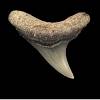 |
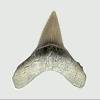 |
Alopias superciliosus (LOWE, 1840) — Bigeye Thresher
Teeth from this species appear to be the less common thresher shark at the mine. Purdy et al (2001) include this as a rare species known from Pungo unit 3. |
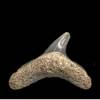 |
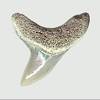 |
Alopias vulpinus (BONNATERRE, 1788) (extant) |
aka A. latidens (LERICHE, 1909) (extinct) Thresher shark.
Relatively common in the mine's tailings. Purdy et al (2001) report A. vulpinus from Pungo Units 4 & 5 & Yorktown 1 & 2. |
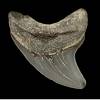 |
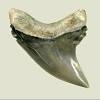 |
"Alopias grandis" (LERICHE, 1942) — Extinct ?Thresher
Teeth of this tooth-design may or may not be alopiid but are rare in Lee Creek sediments. Not included by Purdy et al (2001) as a tooth-design of the fauna. |
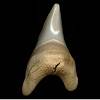 |
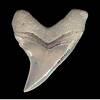 |
Parotodus benedeni (LeHON, 1871)
extinct, False Mako shark
Teeth are large and robust, particularly the root; uncommon and highly desirable. Although, Purdy et al (2001) ascribe these teeth to Yorktown units 1 & 2, specimens have been found in Pungo River sediments. |
|
|